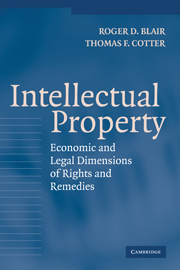Book contents
- Frontmatter
- Contents
- Acknowledgments
- 1 Introduction
- 2 The Law and Economics of IPRs
- 3 A General Theory of Damages Rules
- 4 Departures from the General Theory
- 5 Liability Standards for IPRs
- 6 Who Is an Infringer?
- 7 Who Should Be Entitled to Sue for Infringement?
- 8 Calculating Monetary Damages
- 9 Concluding Remarks
- Bibliography
- Index
2 - The Law and Economics of IPRs
Published online by Cambridge University Press: 08 January 2010
- Frontmatter
- Contents
- Acknowledgments
- 1 Introduction
- 2 The Law and Economics of IPRs
- 3 A General Theory of Damages Rules
- 4 Departures from the General Theory
- 5 Liability Standards for IPRs
- 6 Who Is an Infringer?
- 7 Who Should Be Entitled to Sue for Infringement?
- 8 Calculating Monetary Damages
- 9 Concluding Remarks
- Bibliography
- Index
Summary
In this chapter, we provide an overview of basic patent, trade secret, copyright, and trademark law, and a general sense of the ways in which courts enforce these rights. Our principal focus will be on U.S. law, although from time to time we will examine other countries' laws and how they sometimes differ from U.S. law. With respect to each of these four bodies of law, we first provide a brief description of the legal rights at issue, and then follow with a discussion of the standard economic justifications for, and challenges to, these rights. Finally, we review the debate over whether intellectual property rights (IPRs) are better protected by property or liability rules.
PATENTS AND TRADE SECRETS
Inventions and other industrial know-how sometimes may be subject to ownership under patent or trade secret law. Because the same invention may not be protected by both patent and trade secret law, and because patents usually confer a more robust form of protection, an inventor will usually choose patent over trade secret protection when either is available. In this section, we examine the scope of these bodies of law and their suggested economic underpinnings.
PATENT LAW
To qualify for patent protection, an invention must fall within the scope of patentable subject matter (a machine, process, manufacture, or composition of matter) and must meet the three statutory criteria of novelty, utility, and nonobviousness.
- Type
- Chapter
- Information
- Intellectual PropertyEconomic and Legal Dimensions of Rights and Remedies, pp. 7 - 41Publisher: Cambridge University PressPrint publication year: 2005



